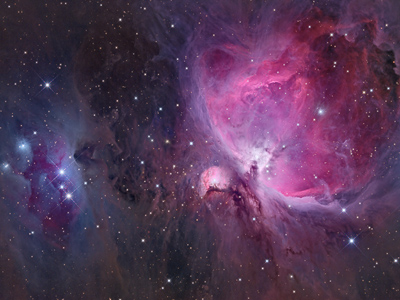
G3-16200 First Light: M42 Great Orion Nebula, author Martin
Myslivec When the first astronomical CCD cameras, intended for amateur
astronomers, were introduced, they offered tremendous quantum
efficiency, showing deep space objects in a fraction of exposure time
compared to film emulsion (plus huge number of other advantages, like
digital image processing etc.). But they suffered from one important
flaw — limited sensor area compared to film and
thus limited field of view.
This situation inverted these days. Cameras like G4-16000 or
G4-9000 offer CCD sensor measuring 37 × 37mm, surpassing
the typical film frame area by 50%. But it is really not easy to put
together optics, capable to cover such giant sensor. And CCDs do not
help the situation with its ability to precisely focus images (we have
immediate feedback while focusing) and to digitally process them so
every optical aberration is clearly visible. Newtonian telescopes need
huge secondary mirrors, 3" focusers and coma-correctors and still fast
setups suffer from vignetting in the edges of the field. ED and APO
refractors also need 3" focusers and field flatteners else large
sensors cannot be used without significant compromises.
G3-16200 uses the proven medium-format G3 camera
shell Here comes the G3-16200 camera with the new KAF-16200 CCD
sensor. While other astronomical cameras use CCD chips primarily
designed for different application fields, KAF-16200 has
“astronomy imaging” stated as the primary application in its
birth certificate.
Sensor dimensions 27.2 × 21.8 mm (35 mm diagonal) are
designed for 2" focusers and correctors, often using M42 or M48
threads. Sensor aspect ratio 5:4 is very close to square to optimally
fit aberration-free circle within the field of view, but also
prolonged enough to allow optimal composition of frame, required by
astro-imagers. Sensor can be used with 2" filters (od unmounted D50mm filters),
which are more common and affordable compared to square 50 × 50mm filters.
Also more filters can fit into the same filter wheel and the G3
design allow usage of internal filter wheel (the G4 cameras can use
external filter wheels only, as the 50 × 50mm filters are
too big to fit into camera head). 6 × 6μm pixels perfectly
correspond to the typical focal lengths of amateur telescopes
(between 50 and 150cm). Smaller pixels
limit dynamic range and sensitivity at no added value, because
resolution is limited by seeing (air turbulences) and optics, rather
than by pixel size. At the same time greater pixels could provide
under-sampled images if optics is good, mount perfectly tracks the
stars and seeing is above average. Read noise around 10e-RMS is well
beyond the sky background noise in the case of long exposures, even
if the very best narrow-band filters are used (no to mention
standard RGB filters). Dark current below 0.1 e-/s/px at
0 °C allows very long exposures, providing
the sensor is used in camera allowing for proper cooling (like the
G3-16200). Quantum efficiency reaching 60% surpasses the QE of very
popular KAF-8300 CCD and is almost identical to e.g. KAF-16803. So
it definitely allows capturing of stunning
astrophotographs.
G3-16200 employs the new KAF-16200 CCD sensor The G3-16200 camera continue in the tradition of Gx astronomical
cameras, used for cutting-edge science as well as for the best
astronomical images by professional and amateur astronomers all over
the world. The G3 system contains models with internal or external
filter wheels, wide variety of telescope adapters, off-axis guiding
adapters, USB and Ethernet interfaces etc.
G3-16200 cameras are supported in the latest SIPS version 2.4 and
newer and in the ASCOM drivers version 3 and newer.
Warning: The G3-16200 camera requires system driver gXccdF.sys
version 2.0 and newer. While the camera as USB device is compatible
with older drivers, its functionality is harmed if it is used with
such driver. It is necessary to update the system driver to the latest
version in the case some version 1.x driver is already installed on
the particular PC e.g. to handle some other camera (e.g.
G2-8300). If the Gx Camera Ethernet Adapter is used, make sure
the device runs firmware version 23 or newer. If some older firmware
is used, update the firmware to version 23 or newer. For details and technical specification, download the G3 Camera
User's Guide or visit the G3
camera description.
|